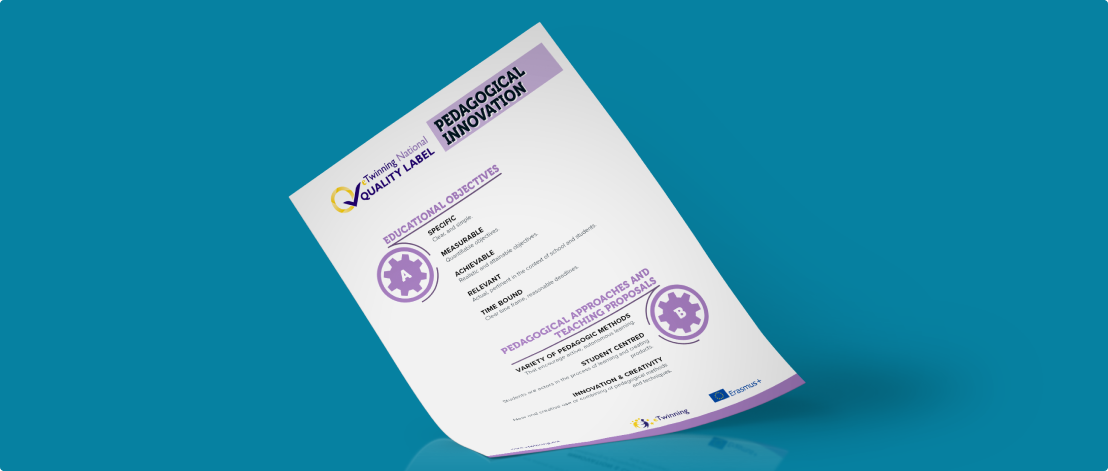Nacionalna oznaka kvalitete
Što je nacionalna oznaka kvalitete
eTwinningova nacionalna oznaka kvalitete dodjeljuje se odgojno-obrazovnim djelatnicima s izvrsnim eTwinningovim projektima. Prijavu za nacionalnu oznaku kvalitete svaki odgojno-obrazovni djelatnik ispunjava osobno. Prijavom za nacionalnu oznaku kvalitete ocjenjuje se osobni angažman svakog pojedinog člana u projektu. Za oznaku kvalitete mogu se prijaviti samo europski projekti (s osnivačima iz dviju različitih zemalja). Nacionalni projekti (s osnivačima iz iste zemlje) ne mogu se prijaviti za Nacionalnu oznaku kvalitete, čak i ako u kasnijoj fazi dodaju partnere iz druge zemlje.
Prijave projekata za nacionalnu oznaku kvalitete zaprimaju se do 30. lipnja 2025. godine. Svaki član eTwinninga može prijaviti najviše četiri projekta. Nakon 30. lipnja 2025. slijedi evaluacija projekata. Svi prijavitelji primit će obavijest o rezultatima evaluacije, neovisno o tome je li prijava odobrena ili odbijena. Dodatne upite pošaljite na: etwinning@ampeu.hr.
Dodatne informacije možete pronaći na Europskoj platformi za školsko obrazovanje: https://school-education.ec.europa.eu/en/recognition/etwinning-national-quality-label
![]()
Kriteriji za oznaku kvalitete
Suradnja između partnerskih škola
- aktivnosti suradnje više su od puke komunikacije
- partnerske škole surađuju pri ostvarivanju zajedničkih aktivnosti
- projektni partneri nisu samo primatelji informacija
- suradničke aktivnosti rezultiraju konkretnim ishodom.
Upotreba tehnologije
- tehnologija je korištena za pomoć pri postizanju pedagoških ciljeva
- alati pomažu projektnim partnerima da bolje međusobno surađuju.
Pedagoški pristup
- projekt je originalan u smislu svoje teme
- koristi se različitim pedagoškim metodama
- učenici su ti koji preuzimaju vodstvo
- učenici komuniciraju sa svojim projektnim partnerima i surađuju koristeći različite metode poput prikupljanja informacija, rješavanja problema, istraživanja i komparativnog rada
- učenici preuzimaju različite uloge kao umjetnici, novinari, tehničari, znanstvenici, glumci itd.
Kurikularna integracija
- projekt je integriran u školski kurikulum i nastavni plan i program
- većina projektnih aktivnosti provodi se tijekom školskih sati
- kurikularna integracija u projektu je jasna
- projektni rad učenicima omogućuje razvoj vještina i kompetencija
- pedagoški okvir temeljen na projektu učitelj je objasnio i dokumentirao.
Rezultati i dokumentacija
- rezultati projekta predstavljeni su online
- studenti su uključeni u TwinSpace
- svi koraci projekta su dokumentirani, uključujući planiranje, opise aktivnosti, evaluaciju i povratne informacije
- ocjenjujete i objavljujete utjecaj koji je projekt imao na učenike i nastavnike uključene u projekt
- koristite kontrolni popis kada planirate i provodite svoj projekt kako biste provjerili ispunjava li vaš projekt kriterije kvalitete
Kako se prijaviti
- prijavite se u eTwinning na Europskoj platformi za školsko obrazovanje
- idite na projekte
- pronađite svoj projekt i kliknite na Prijava za oznaku kvalitete
- ispunite sva polja sa svim potrebnim informacijama i priložite dokaze o svojem radu



